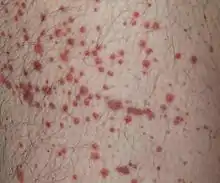| Amyloid purpura | |
|---|---|
 | |
| Purpura | |
| Specialty | Dermatology |
Amyloid purpura is a condition marked by bleeding under the skin (purpura) in some individuals with amyloidosis.[1] Its cause is unknown, but coagulation defects caused by amyloid are thought to contribute.
Presentation
Amyloid purpura usually occurs above the nipple-line and is found in the webbing of the neck and in the face and eyelids.[1]
Cause
The precise cause of amyloid purpura is unknown, but several mechanisms are thought to contribute.[2] One may be a decrease in the level of circulating factor X,[2] a clotting factor necessary for coagulation. The proposed mechanism for this decrease in factor X is that circulating amyloid fibrils bind and inactivate factor X.[2] Another contributing factor may be enhanced fibrinolysis,[2] the breakdown of clots. Subendothelial deposits of amyloid may weaken blood vessels and lead to the extravasation of blood.[2][3] Amyloid deposits in the gastrointestinal tract and liver may also play a role in the development of amyloid purpura.[2]
Diagnosis
Treatment
Epidemiology
Amyloid purpura affects a minority of individuals with amyloidosis.[1] For example, purpura is present early in the disease in approximately 15% of patients with primary systemic amyloidosis.[4]
See also
References
- 1 2 3 Eder L, Bitterman H (June 2007). "Image in clinical medicine. Amyloid purpura". N. Engl. J. Med. 356 (23): 2406. doi:10.1056/NEJMicm061510. PMID 17554122.
- 1 2 3 4 5 6 Gamba G, Montani N, Anesi E, et al. (March 2000). "Clotting alterations in primary systemic amyloidosis" (PDF). Haematologica. 85 (3): 289–92. PMID 10702818.
- ↑ Amyloidosis, Immunoglobulin-Related at eMedicine
- ↑ Kyle RA, Gertz MA (January 1995). "Primary systemic amyloidosis: clinical and laboratory features in 474 cases". Semin. Hematol. 32 (1): 45–59. PMID 7878478.